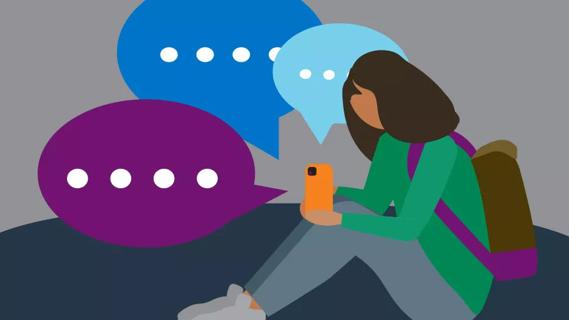Embracing both can be healthy

When it comes to body acceptance, two camps of thought seem to dominate the conversation. Some people subscribe to body positivity, or loving their bodies regardless of shape, size, color, sex or ability. Others embrace body neutrality, which focuses on appreciating what the body can do.
Advertisement
Cleveland Clinic is a non-profit academic medical center. Advertising on our site helps support our mission. We do not endorse non-Cleveland Clinic products or services. Policy
Is one better than the other or should we just find a good balance between the two? Psychologist Susan Albers, PsyD, gives us overviews of both movements and some tips for how we can make peace with our bodies.
“In a larger context, body positivity is a social movement that advocates for the acceptance of all bodies, regardless of size, shape, skin tone, sex or physical abilities,” says Dr. Albers. She adds that this movement challenges unrealistic beauty standards and ideals. “The central concept is the idea that beauty is constructed by society and it should not determine someone’s self-worth or value.”
Many say that the fat rights movement of the 1960s gave way to body positivity. After reading an article about anti-fatness and diet culture in the United States called “More People Should Be FAT!”, Bill Fabrey reached out to its author, Lew Louderback. Both men were tired of seeing people who were fat mistreated, so they worked together to organize a small group of like-minded people. This group became known as the National Association to Aid Fat Americans and they worked to improve life for the fat community through education and advocacy. Today, the group is called the National Association to Advance Fat Acceptance (NAAFA).
Advertisement
While the movement was off to a solid start, The Fat Underground, a feminist group out of California, wanted to see even more change. The group wanted equal rights for fat people and saw diet culture as an enemy of the community. Their Fat Liberation Manifesto motivated others to work with them. Their efforts ended up making a substantial impact in the United States and around the world.
As more people started interacting online between the late 1990s and early 2000s, cyberbullying and body shaming became the norm. To block out the negativity, fat activists and their allies became more vocal — and visible. While society might have wanted them to hide in the real world, the fat community wasn’t hiding on the internet. As they celebrated their bodies and style, this empowered others to take part and embrace who they were.
While its overall intention was good, the body positivity movement has gained some criticism over the years. Some have pointed out that the movement often leaves people out of the conversation. Casting a wider net was instrumental in helping the fat acceptance and fat liberation movements gain momentum.
Another criticism is that body positivity can be very unrealistic at times.
“Body positivity is a subset of toxic positivity,” notes Dr. Albers. “Some feel that it blames people for how they feel based on their mindset. It can also push people into trying to feel something that they don’t.”
According to Dr. Albers, while body positivity’s intentions are admirable, unconditionally loving one’s body and appearance can seem unrealistic to a lot of people, particularly because so many report being unhappy about them.
“Body positivity wouldn’t even be needed if we appreciated and found all bodies inherently beautiful. Society is reflective of what our culture and environments teach us to believe — to dislike our bodies for so many reasons,” explains Dr. Albers.
Body neutrality doesn’t mean that you feel meh about your body 24/7. It also isn’t centered on appearance.
“Body neutrality is a middle-of-the-road approach between body positivity and body negativity,” says Dr. Albers. “As the term suggests, it is neither loving nor hating your body. It’s based on the notions of acceptance and having respect for one’s body rather than love.”
It’s believed that the term “body neutrality” started popping up online around 2015. It became even more popular when Anne Poirier, a certified intuitive eating counselor and eating disorder specialist, started using the phrase to help clients build a healthier balance between food and exercise. Poirier defined body neutrality as “prioritizing the body’s function and what it can do rather than its appearance.” According to Poirier, we don’t have to love or hate our bodies. We can feel neutral about them.
Advertisement
“The approach acknowledges that your body is only one part of who you are — not the totality. It also shouldn’t dominate how you feel about yourself,” says Dr. Albers. Another thing to keep in mind is that your body is largely influenced by genetics and that’s all out of your control. “You can’t change or manipulate it and trying to do so can cause harm,” she adds.
The key difference between these two movements rests in the idea of value.
“The body-neutral approach leans toward the belief that it doesn’t matter if you think your body is beautiful or not. Your value is not tied to your body nor does your happiness depend on what you look like. A body-positive approach says you are beautiful no matter what. Period,” Dr. Albers explains.
Which movement should you follow? It all comes down to your preference and how you feel about your body. Here, Dr. Albers highlights some pros and cons of body positivity and body neutrality.
If you’re inspired by positive thoughts and affirmations, body positivity might be your thing. Dr. Albers says positive thoughts can help your mood and rewire negative thoughts. Body positivity can also help dissolve thoughts that we might have picked up from childhood or society.
Advertisement
“A ‘pro’ of body positivity is that it can help chip away at thoughts that come from diet culture — the ones that make us believe that our bodies are not worth loving unless they are a particular shape or size,” she says.
On the other hand, if positive affirmations seem a little too “Stuart Smalley” for you, body neutrality may be the place to start.
“Being positive when you truly don’t feel that way might seem inauthentic and not coherent with how you genuinely feel. It’s a huge leap from ‘I hate my body’ to ‘I love it.’ By going in the direction of ‘I can accept my body,’ you take out any indication of ‘good’ or ‘bad.’ And that might simply be closer to where you are,” Dr. Albers says.
Another positive of body neutrality is that it’s realistic and obtainable for many. Dr. Albers says it also makes you unpack some of the feelings that you have about your physique.
“Body neutrality makes you dig deep and ask those questions about how you came to adopt and internalize the unrealistic beauty standards and ideals,” she explains. “It gives you a break from that nagging inner voice because you simply choose not to entertain it. This allows you to devote more time and energy to other important things in your life.”
Advertisement
But a downside of body neutrality is that it can keep you stuck in a vortex of missing the truly beautiful and lovely things about yourself.
And yet, the “good vibes only” feel of body positivity could lead to more complex issues.
Dr. Albers explains.
“Telling people to love their bodies when they truly don’t can teach people to further suppress their feelings. Suppressing emotions is linked with higher levels of anxiety, depression, eating disorders and sometimes, in the extreme, suicide.”
Good intentions and burying true feelings can be overwhelming for someone who is living with an eating disorder. Dr. Albers says that body positivity can be a huge leap from where someone genuinely is. “You can’t force a positive feeling when it just isn’t there. Pretending can do more harm than good. It can lead someone to feel guilty, ashamed and more depressed,” cautions Dr. Albers.
There’s nothing wrong with embracing a little bit of body positivity and a little bit of body neutrality at the same time. You can try applying them when and where they make the most sense.
“It can be helpful to hang body-positive affirmation statements in easy-to-see locations like your mirror, refrigerator or on your desk. These messages will seep into your subconscious every time you take a glance at them,” suggests Dr. Albers.
These statements could include:
You might even want to get a little more social with your affirmations.
“A body-positive approach would be to add some positive affirmations to your social media feed. You might even take unfiltered, natural pictures of yourself having fun versus staged photos at your best angle. Also, acknowledge in your posts what you appreciate about your body. This helps other people to see that it is OK to like your body,” she adds.
“A lot of body dissatisfaction comes from comparing yourself to what your body looked like in the past. Instead, mindfulness trains your mind to focus on right now — and what you currently look like,” encourages Dr. Albers. She says mindfulness is rooted in the language of nonjudgment. It’s just observing, being aware and taking note. This assigns no value or indication of whether something is good or bad.
Examples of body-neutral statements that we can use include:
Sometimes, we say things about our bodies and we don’t even realize how our words can affect how our little ones see themselves. Dr. Albers offers these tips for how we can be better examples for our children.
Learn more about our editorial process.
Advertisement

Focusing on non-physical attributes, practicing body positivity or neutrality, and avoiding comparisons can help

This pattern of self-doubt leads you to worry that someone will discover you’re a fraud and that you don’t deserve the success you’ve earned

Obsessively assessing your appearance? Cognitive behavioral therapy and journaling can help you figure out why you’re doing it — and how to stop

It’s a continual process, but through meaningful practices, you can find peace and positivity with yourself

Horoscopes, fortunetellers and personality tests all feed into our cognitive biases and reinforce our own feelings as true

Ignore the negative self-talk, practice positive affirmations and remember, you’re not perfect — and that’s OK!

Foster communication about social media, encourage whole-person attributes and be mindful of your own negative self-talk

Filters and editing can lead to low self-esteem, depression and even body dysmorphic disorder

If you’re feeling short of breath, sleep can be tough — propping yourself up or sleeping on your side may help

If you fear the unknown or find yourself needing reassurance often, you may identify with this attachment style

If you’re looking to boost your gut health, it’s better to get fiber from whole foods